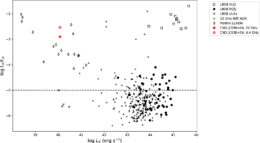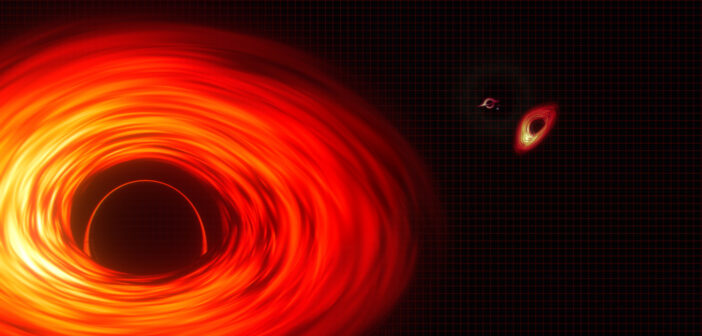A chance observation during a survey of active galactic nuclei opened a new window onto an ultra-luminous X-ray source that may be an intermediate-mass black hole.
Looking for the Missing Black Hole Pieces

The Laser Interferometer Gravitational-Wave Observatory (LIGO) announced in 2020 the detection of a merger that resulted in a 142-solar-mass black hole, the largest merger product detected by LIGO to date. [LIGO/Caltech/MIT/R. Hurt (IPAC)]
Intermediate-mass black holes likely announce themselves the same way that stellar-mass and supermassive black holes do: by shining brightly across the electromagnetic spectrum when they consume material from their surroundings. Bright X-ray emission may have exposed the location of an intermediate-mass black hole in the outskirts of the galaxy NGC 5252. The source, named CXO J133815.6+043255, or CXO J1338+04 for short, is thought to be surrounded by swirling metal-poor gas. This hints that CXO J1338+04 could have been the central black hole of a metal-poor dwarf galaxy that merged with NGC 5252.

Radio image showing CXO J1338+04’s location relative to the center of NGC 5252. [Adapted from Smith et al. 2023]
A Long-Wavelength Look at CXO J1338+04
Recently, Krista Lynne Smith (Texas A&M University and Southern Methodist University) and collaborators used the Very Large Array to observe the nucleus of NGC 5252 as part of their study of nearby active galactic nuclei: luminous galactic centers powered by accreting supermassive black holes. By chance, their field of view encompassed CXO J1338+04, which shines brightly at the 22 gigahertz frequency of their observations.
Combining their new data with archival radio observations at lower frequencies, Smith’s team measured the slope of CXO J1338+04’s spectral energy distribution and found it to be consistent with expectations for an outflowing jet that could arise from an accreting black hole. The team noted that the observed spectral slope could also match that of a star-forming region, but they find that unlikely, especially since previous studies found active galactic nucleus–like optical emission lines that are hard to explain with star formation.
Further Support

Ratio of radio and X-ray luminosities at two frequencies (red stars) for CXO J1338+04 compared to radio-loud quasars, radio-quiet quasars, and other active galactic nuclei and ultra-luminous X-ray sources. Click to enlarge. [Smith et al. 2023]
Taken together, CXO J1338+04’s spectral slope and radio emission match what’s expected for an accreting intermediate-mass black hole, supporting its inclusion on the small but steadily growing list of promising intermediate-mass black hole candidates.
Citation
“The Nature of the IMBH Candidate CXO J133815.6+043255: High-Frequency Radio Emission,” Krista Lynne Smith et al 2023 ApJ 956 3. doi:10.3847/1538-4357/acf4f8
